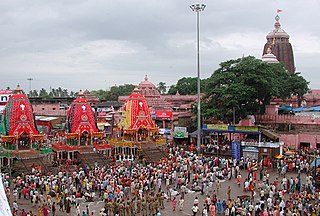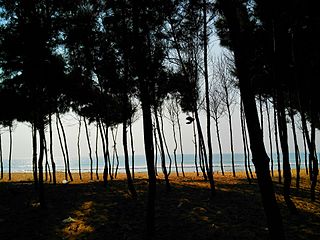
Odisha, formerly Orissa, is an Indian state located in Eastern India. It is the 8th largest state by area, and the 11th largest by population. The state has the third largest population of Scheduled Tribes in India. It neighbours the states of Jharkhand and West Bengal to the north, Chhattisgarh to the west, and Andhra Pradesh to the south. Odisha has a coastline of 485 kilometres (301 mi) along the Bay of Bengal in Indian Ocean. The region is also known as Utkala and is also mentioned in India's national anthem, "Jana Gana Mana". The language of Odisha is Odia, which is one of the Classical Languages of India.

Odia is an Indo-Aryan language spoken in the Indian state of Odisha. It is the official language in Odisha, where native speakers make up 82% of the population, and it is also spoken in parts of West Bengal, Jharkhand, Andhra Pradesh and Chhattisgarh. Odia is one of the many official languages of India; it is the official language of Odisha and the second official language of Jharkhand. The language is also spoken by a sizeable population of 700,000 people in Chhattisgarh.

Jagannath is a deity worshipped in regional Hindu traditions in India and Bangladesh as part of a triad along with his brother Balabhadra, and sister, Subhadra. Jagannath, within Odia Hinduism, is the supreme god, Purushottama, and the Para Brahman. To most Vaishnava Hindus, particularly the Krishnaites, Jagannath is an abstract representation of Krishna, or Vishnu, sometimes as the avatar of Krishna or Vishnu. To some Shaiva and Shakta Hindus, he is a symmetry-filled tantric form of Bhairava, a fierce manifestation of Shiva associated with annihilation.

Ratha Yatra is a Hindu festival associated with Lord Jagannath held at Shri Khetra Puri Dham in the state of Odisha, India. It is the oldest Ratha Yatra, whose descriptions can be found in Brahma Purana, Padma Purana, and Skanda Purana and Kapila Samhita. Rath Yatra or Jatra is the celebration of the Lord Jagannath, who is believed to be the Lord of Universe's journey towards his aunt's house.

Cuttack district is one of the 30 districts of Odisha state in India. It is located in the coastal part of the state and its administrative headquarters are located in the city of Cuttack. As of 2011 Census, after Ganjam, it is the second most populous district of Odisha, with a population of 2,624,470. The name is an anglicized form of Kataka or Katak meaning Fort – referring to the Barabati Fort. The district is bisected by the river Mahanadi and its numerous distributaries and occupies a large portion of the river's delta. It is bounded by the Angul, Dhenkanal, Nayagarh and Khurda districts to the west while its southern and eastern boundaries touch Puri, Jagatsinghpur, Kendrapara and Jajpur districts.

Puri district is a coastal district of the Odisha state of India. It has one sub-division, 11 tahasils and 11 blocks and comprises 1722 revenue villages. Puri is the only municipality of the district. Konark, Pipili and Nimapara are the three NACs in this district. Satyabadi, Gop, Kakatpur and Brahmagiri are major semi-urban areas.
The Odia (ଓଡ଼ିଆ), formerly spelled Oriya, is a Indo-Aryan ethnic group native to the Indian state of Odisha who speak Odia language. They constitute a majority in the eastern coastal state, with significant minority populations in neighboring Andhra Pradesh, Chhattisgarh, Jharkhand and West Bengal.

John Beames was a civil servant and author in British India. He served in the Punjab from March 1859 to late 1861, and in Bengal from December 1861 until the conclusion of his service in 1893. He was also a scholar of Indian history, literature and linguistics. His great work was a comparative grammar of Indo-Aryan languages, published in three volumes in 1872–1879. When he retired from the Indian Civil Service in March 1893, he had gained extensive knowledge of Indian life, and in 1896 wrote an account of his career, first published in 1961 as Memoirs of a Bengal Civilian.
Odia Muslims are a community of people hailing from the Indian state of Odisha who follow Islam and primarily speak Odia language. They mostly descend from indigenous converts to Islam along with a small proportion that migrated from northern India. They are marked by their distinctive religious practices, food habits and language.
Tourism in Odisha is one of the main contributors to the Economy of Odisha, India, with a 500 km (310 mi) long coastline, mountains, lakes, natural biodiversity and rivers. Odisha is one of the major tourism sectors of India, with various tourists' attractions, ranging from wildlife reserves, beaches, temples, monuments, the arts and festivals. Other than wildlife reserves, beaches, temples, monuments, the arts and festivals, the Odisha Tourism Development Corporation, a Public Sector Undertaking of Government of Odisha, is also developing tourism sector of Odisha and India.
The Indian state of Odisha has a rich cultural and artistic heritage. Due to the reign of many different rulers in the past, arts and crafts in Odisha underwent many changes giving an artistic diversity today in the forms of traditional handicrafts, painting and carving, dance and music, clothing, etc.
Followers of Christianity are a significant minority in Odisha state of India. According to the 2011 Census, Christians make up about 2.77% of the population. Kurukh, Sora, Kharia and Panos are notable ethnic groups with a significant Christian population.

'Suramani' PanditRaghunath Panigrahi was an Odissi music Guru, vocalist, composer and music director. He is most known for his renditions of Jayadeva's Gita Govinda and his vocal support for his wife, the Odissi danseuse Sanjukta Panigrahi. Raghunath belonged to a family associated with Odissi music for centuries, members of which were 19th-century Odissi poet-composer Sadhaka Kabi Gourahari Parichha and Gayaka Siromani Apanna Panigrahi who was the royal musician (raja-sangitagya) of Paralakhemundi. He started his musical training from his father Pt Neelamani Panigrahi, who had been collecting traditional Odissi melodies of the Gita Govinda from the Jagannatha Temple of Puri. Later, Raghunath continued learning Odissi music under Pt Narasingha Nandasarma and Pt Biswanatha Das. He was widely known as 'Gitagobinda Panigrahi'.

Baleswari Odia, also Northern Odia or North Balasore Odia, is a dialect of Odia spoken in the northern regions of Indian state of Odisha. It is spoken in the districts of Balasore, Bhadrak, Mayurbhanj and Kendujhar.

Gourahari Das is a creative writer, journalist and an academician.
Dinakrushna Dasa (1650–1710) was an Odia poet, belonging to the Vaishnava tradition of Bhakti movement. He is known for his Odia poem titled "Rasakallola", which is devoted to Lord Krishna. Among his many literary compositions, "Artatrana Chautisa" is a reputed one. Dinakrusna's Rasakallola and his standalone compositions including "chaupadi", "prabhati", "janana", "chautisa", "bhajana", and "malasri" are central to the repertoire of Odissi music, the traditional classical music of the state.

Kamalakanta Jena is an Indian educator, popular science and science text book writer in Odia. He has received awards for his books and articles.

Pandit Nilakantha Das (1884-1967) was one of the most illustrious sons of Odisha, who appeared both in its political and literary arena at the most crucial period of its history, when Odisha had no political identity in the map of India, and Odia as a language was about to be extinct. He worked relentlessly for Odisha's recognition both politically and linguistically, and helped bring to fruition the dreams of Utkala Gaurab Madhusudan Das, Utkalamani Gopabandhu Das and all other Odia loving people.

The 12875 / 12876 Neelachal Express is a tri-weekly train which runs between Puri in Odisha and Anand Vihar Terminal railway station. It is one of the oldest train that connects Puri to Anand Vihar Terminal. The main towns along the route are Bhubaneshwar, Cuttack, Bhadrak, Balasore, Hijili, Tatanagar, Bokaro Steel City, Muri, Gaya, Mughalsarai, Varanasi, Bhadohi, Rae Bareli, Lucknow, Kanpur. It operates three times per week and covers a distance of 1,912 kilometres (1,188 mi) from Puri to Anand Vihar Terminal. Neelachal Express consist of 1 AC First Class coach, 1 Second AC coach, 6 Third AC coaches, 8 Sleeper Class coaches, 2 General (Un-Reserved) coaches, 1 Pantry Car and 2 EOG.
The 18410 Puri–Howrah Sri Jagannath Express is an Express train belonging to Indian Railways – East Coast Railway zone that runs between Puri & Shalimar in India.











